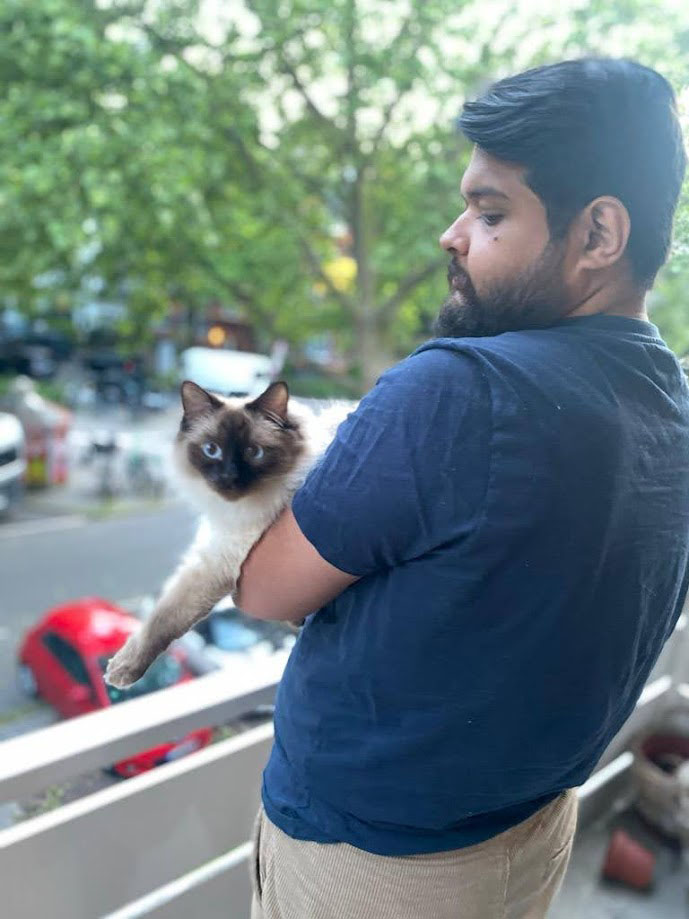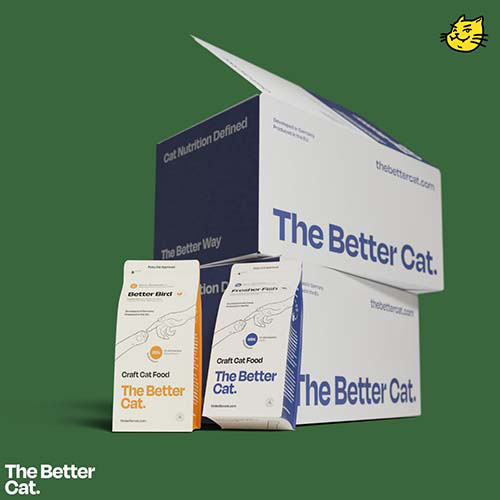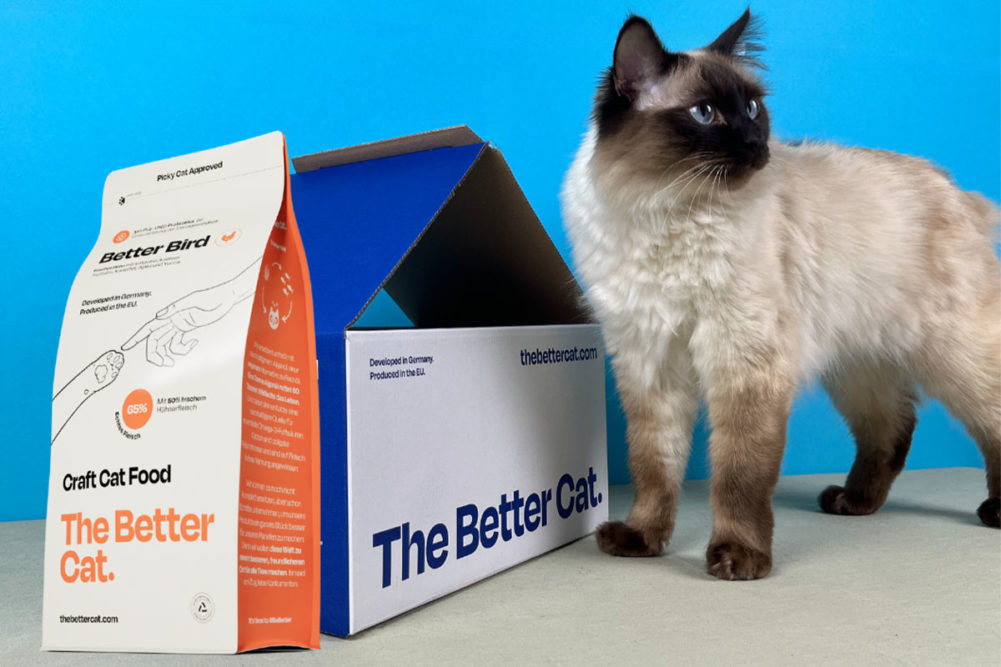BERLIN — When shopping for pet food, treats and supplements, consumers have a wealth of options to choose from. Whether pet parents are seeking products that boast new, innovative formats, functional ingredients to address specific health issues, or products that tout sustainability benefits, pet parents can find it all through the aisles of pet specialty retailers, grocery stores and even online.
However limitless the offerings may seem, the nutrition offerings for dogs far exceed those for cats. For example, just this past year, Pet Food Processing has covered 94 new dog foods, treats and supplements and just 21 new nutrition products for cats.
A new German pet food company is determined to change this by expanding and improving the offerings for felines. Toward the end of November, The Better Cat launched with a goal to create sustainable, cat-tailored products formulated with premium nutritional value.
 Co-Founder Rachit Shadra and his cat Obi, the inspiration behind The Better Cat. (Source: Rachit Shadra)
Co-Founder Rachit Shadra and his cat Obi, the inspiration behind The Better Cat. (Source: Rachit Shadra)
Founded by Rachit Shadra, an experienced startup professional, and Niklas Köster, a former investment banker with experience in e-commerce and direct-to-consumer (DTC) products, The Better Cat seeks to establish a more modern cat food brand, targeting Millennials and Gen Z cat parents through superior cat nutrition products.
“We never say that we are redefining cat nutrition,” Shadra said in an exclusive interview with Pet Food Processing. “We say that we're defining cat nutrition; it was never defined in the past. It was always a hand-me-down of dog nutrition, which should not be the standard for cats.”
Cat-first focus
Shadra was inspired to create The Better Cat upon noticing a lack of healthcare for cats. After taking his cat to a veterinarian, Shadra was often given medications that were designed for dogs, and sometimes horses.
“I was very taken aback. It was like offering a human medicine you would give to a gorilla just because we are similar species,” he shared. “It became very, very clear about the massive underserved nature of healthcare for cats… and you can't really fix healthcare without fixing nutrition.”
As well as a general lack of healthcare, Shadra also noticed a dog-first mentality within the pet nutrition industry and a wealth of cat parents seeking more nutritious diets for their cats throughout the European Union.
“It doesn't matter how well your cat plays or how active it is if you don't give them the right food over a period of time,” he explained “If you’re failing to provide high nutrition, you’re basically stopping them from having the quality of life that they could have if they got the best food out there. When you look at cat food, it’s all a derivative of dog recipes. Looking at the original kibble that was created, the wet food, it's all recipes that are protein driven for dogs and then adapted for cats.”
Though cat ownership comes second to dogs in the United States, the same cannot be said for the European Union, where the cat population easily outpaces that of dogs. According to the European Pet Food Industry Federation’s (FEDIAF) “Facts & Figures 2021” report, there are 113.6 million cats compared to 92.9 million dogs throughout Europe.
“When I started looking at the market, I was actually very, very surprised, as, in Germany, there are 17 million cats compared to 10 million dogs,” Shadra detailed. “[Cat nutrition] is actually the largest segment and the fastest growing segment of pet food.”
To help meet demand for cat-specialized nutrition, Shadra leveraged his extensive experience in building startups, including his work with Wunder Mobility and Heyjobs, to launch The Better Cat in November 2022 after working on the company for a year and a half.
According to data from Fortune Business Insights and shared by The Better Cat, the global pet food market topped $110 billion in 2021, driven by increases in pet ownership brought on by COVID-19.
Millennials and Gen Z combined account for nearly half (46%) of US pet owners, according to Vol. 4 of the American Pet Product Association (APPA)’s Generational Report, a number that is only expected to rise throughout the globe as more Gen Zers become adults and adopt their own pets. With this in mind, Shadra saw an opportunity to enter the market specifically targeting these demographics.
“There was a massive boom in pet ownership during the COVID crisis, which made people a lot more aware about the value pets would add to their life,” he said. “I thought that there were enough people [creating tailored nutrition] for dogs. Why not try to do something for cats? My own cat, Obi, was the biggest inspiration behind The Better Cat.”
The Better Cat’s focus on Millennial and Gen Z cat parents is driven by the unique relationship these demographics have with their pets. This unique relationship has spiked consumer interest in functional pet foods, including those targeting specific health concerns, species and breeds.
“We observed that Millennials and Gen Zers share a very different relationship with their pets compared to Gen X and Boomers,” he said. “[Millennials and Gen Z] grew up with these animals as our siblings; we never saw them as an accessory for the family or something that helps reduce the amount of engagement that you would have to otherwise put into your house.
“The relationship between animal and human has evolved,” Shadra added. “It's no longer the same, and the demands that exist for better cat food do not come from Boomers and Gen X — primarily they come from Millennials and Gen Z. I think it's very, very clear, also, that Millennials are now the primary spenders on consumer goods, to a certain extent, and they really care about different things for their animals compared to [older generations].”
The path to launch
Before launching, Shadra and The Better Cat had to overcome a wealth of challenges. Funding, however, never became an issue for the company. Alongside its official launch, The Better Cat also closed its pre-seed funding round led by FoodLabs, a venture capital firm that invests in the food tech space.
“We are excited to be partnering with Rachit and Niklas on their ambitious journey to revamp the cat food landscape — one that has seen little innovation over the last 50 years,” said Till Hölzer, an investor at FoodLabs.
According to Shadra, the company raised upwards of €500,000 ($538,100 USD) through the funding round. Following such significant funding success, The Better Cat plans to seek additional funding to advance its expansion plans.
“Our vision is to build the future of animal care, and we’re glad to have won such experienced investors to back us,” Shadra said. “With high-quality products, we’re breaking the monotony of food that is harmful for your cat by introducing science-backed recipes.”
Outside funding, Shadra shared The Better Cat experienced two big issues: a lack of industry information and supply chain disruptions.
 Founded in November 2022, The Better Cat's goal is to help improve cat health care and nutrition. (Source: The Better Cat)
Founded in November 2022, The Better Cat's goal is to help improve cat health care and nutrition. (Source: The Better Cat)
“The biggest issue was just the sheer lack of information about cat health that we could build upon,” he explained. “In order to be able to come up with recipes that actually have a positive impact, we need to know where to start. We needed to know what the baseline is [for cat nutrition]. The first thing that we actually did was hire a veterinarian, who had become a product developer, and we were able to bring her on board to help us design a formula that cats would actually love to eat.”
The company added Veronika Broukal, DVM, to its team in August 2022. Broukal helped the company develop its formulas specific to the lifestyle of modern-day house cats, which have different lifestyles compared to their wild predecessors.
“We had to work with a person who actually specialized in cat healthcare,” Shadra said. “The other [challenge] was the ability to source ingredients at a time where there was a massive supply chain crisis going on in the world.”
To help navigate the volatile supply chain environment, The Better Cat consulted senior leadership personnel from European pet food company Pets Deli and one of America's largest cat food startups. Acting as advisors, the leaders were able to provide Shadra with their approaches to cat-specific nutrition and the challenges they would inevitably bring, including the ability to find the right supplier that would be able to offer expertise and overcome supply chain issues.
“[We needed] to find a supplier that would help us secure the right ingredients, allow us to launch on time, test the product, and build on the baseline that exists in the market,” Shadra detailed. “Sustainability is also a core concept for us, so we did not want to import all of our meat from Asia and import all of our materials from across the world in shipping containers and then sell it in a different country. We wanted to bring on a supplier who would help us locally source at least 95% of our ingredients, especially meat, which has a very high carbon footprint in Europe, and we were able to do that.”
A balancing act
When originally creating its first cat nutrition products, The Better Cat decided to focus on existing formats and improving them with boosted nutritional value. The company decided to tackle dry cat food upon its entrance to the market.
The Better Cat currently offers a dry cat food line consisting of one chicken and one salmon recipe. The recipes are formulated with 65% real meat, including at least 50% fresh chicken or salmon, as well as pre- and probiotics, peas, beet root, apples, parsley, marigold, and superfoods such as Brewer’s Yeast, Nettle, Yucca Root, Linseed, and Marigold.
The company’s products are currently developed in Germany by The Better Cat’s team of veterinary nutritionists and produced at a facility in France. The formulas are available on a subscription basis or through individual purchases in the European Union via The Better Cat’s e-commerce platform.
The cat food also contains algae oil, replacing salmon oil while offering the same amount of Omega fatty acids and ensuring sustainability. Using algae oil instead of salmon oil allows the company to save about 60 metric tonnes of wild salmon. According to The Better Cat, it is the first in Europe to fully replace salmon oil with vegan algae oil in its pet food products.
 Currently, The Better Cat offers two dry formulas: one chicken recipe and one salmon recipe. (Source: The Better Cat)
Currently, The Better Cat offers two dry formulas: one chicken recipe and one salmon recipe. (Source: The Better Cat)
The idea to replace salmon oil with algae came from the company’s team of veterinary nutritionists and was driven by supplier partnerships, as well as a commitment to the environment. Fish oil, which is often included in cat food formulas and serves as a significant source of Omegas, is produced from various fish sources, including salmon. However, fish do not produce their own Omegas; instead, they consume them from algae and seaweed, which are naturally rich in Omega fatty acids.
The Better Cat’s idea in replacing salmon oil with algae oil was to cut out the middleman — the salmon — and focus on the actual, natural source of the Omegas, therefore reducing the company’s impact on the environment and stress on the salmon population.
“The head of research on our supplier side actually informed us that they had experimented with algae oil to produce cat food, and they were able to maintain the same amount of Omega levels as fish oil,” Shadra explained.
The use of vegan algae oil is just one of the many ways The Better Cat is embracing sustainability throughout its entire business, from decarbonization efforts to fully recyclable packaging.
“We take a different approach toward sustainability,” he said. “We try to first minimize as much carbon as we can and whatever is leftover we try to offset. That's what went into our logic towards understanding whether we want to use salmon or algae oil: let's minimize the carbon emissions any way we can.”
The Better Cat tries to source as many of its ingredients from regional farms and suppliers as possible to further reduce its carbon emissions. This regional sourcing means that The Better Cat does not use produce that is not native to the European Union. The company also looks for replacement ingredients that could provide environmental benefits without compromising the nutritional value of its formulations.
“We wanted to strike a balance,” Shadra said. “We didn't want to compromise on animal health and use the right ingredients but, at the same time, we wanted to research ingredients we could effectively replace.”
To offset any emissions and reduce its environmental footprint, The Better Cat has partnered with ClimatePartner and has invested in clean ocean and renewable energy projects throughout the Philippines, India and Aruba. The company’s product packaging is also fully recyclable and carbon neutral.
Scaling for the future
With a successful pre-seed funding round behind them, The Better Cat has several expansion plans, as well as plans to seek additional funding to support its future growth. The company expects to use the pre-seed funding to increase its sales and marketing efforts, as well as launch two new product lines: cat snacks and wet diets.
Following its methodology of improving cat nutrition, the company is currently undergoing product testing for a new cat snack treat. The Better Cat’s upcoming cat snack serves as an “evolution of cat snacks,” Shadra revealed. The freeze-dried chicken liver treat will be formulated with 95% chicken meat and includes prebiotics to support digestive health. According to Shadra, the treat will be 95% raw and completely unprocessed.
According to Shadra, the cat snack will launch in the next two to three weeks.
The company is also working on a wet formula that could be “universally accepted by all cats,” Shadra hinted. The wet cat food will be made with fresh meat, prebiotics and supplements to support overall health.
Shadra also revealed that the company plans to hire key personnel to expand its business and hopes to expand its retail footprint.
“Even though we sell fully online right now, we know for a fact that at some point we want to place our products in specialty pet stores,” he detailed. “We want to make sure that we work with strategic partners who share the same values as we do when it comes to animal health. Building a team that could help us take our business development and strategic partnerships to the next level is a priority for us.”
Read more news from pet food manufacturers.





